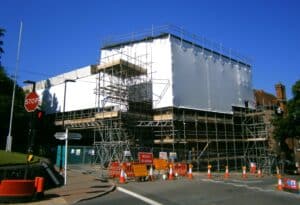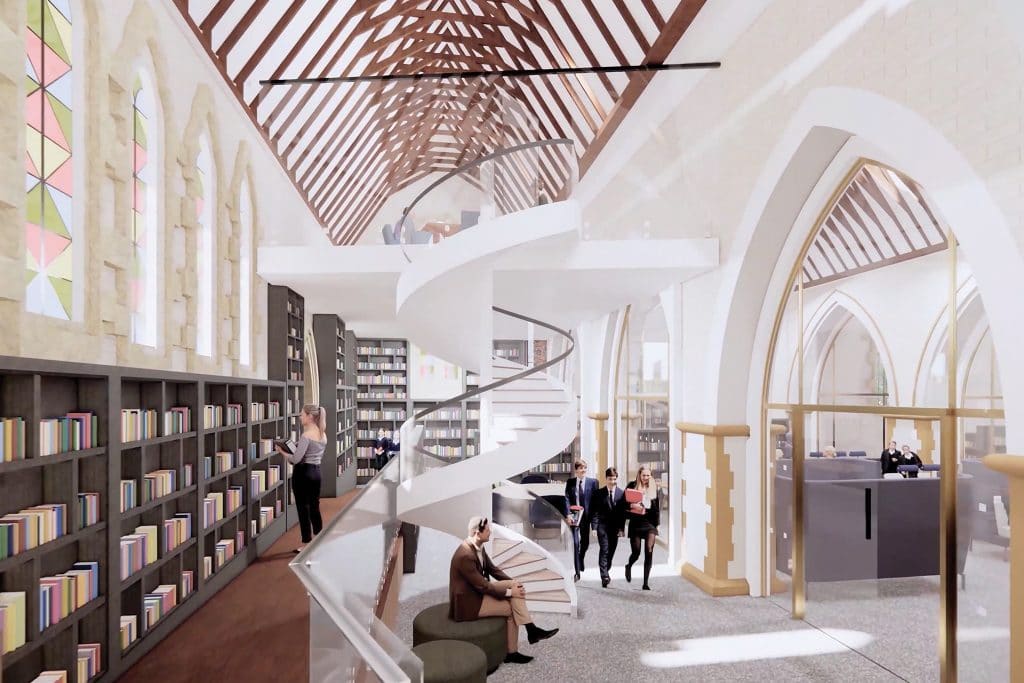Army House Project and restrictions to access to Ashampstead Road
This page was updated on Thursday 26/06/2025
The next period of road closure will start on Monday 30/06/2025 and will last for up to 3 weeks – ending on or before Friday 18/07/2025. During this period, Ashampstead Road will be CLOSED Mondays to Fridays between 08:15 and 16:00 and open under 4 way lights to cars and LGVs at all other times. The closure is so that scaffolding can be removed from the first section of the building.
This website will be next updated once we are able to confirm when the road will re-open.
Between February and November 2025, major repairs are taking place to Army House – one of our Grade II listed boarding houses. This follows an independent report into the building’s condition which identified that the roof is at serious risk of failure and in need of replacement. If left as it is, there is a real risk of falling tiles injuriAng pedestrians or damaging vehicles. If this were to happen, the repairs could become an unplanned project resulting in a much longer and more disruptive period of road closures and traffic management. It is therefore something that has to be done now to protect the safety of those living in and around Bradfield village and those that pass through it and will restore the building to an acceptable standard for the foreseeable future.
Due to the complexity and scale of the works involved, including extensive scaffolding and temporary roof, on an occupied listed building with ecological constraints, adjacent to a narrow road (see FAQs below for more detail) we were initially advised that a complete road closure would be required for the duration of the project.
We have worked closely with our contractors and professional advisers to avoid a full closure except when it is absolutely necessary for reasons of public safety. A road closure is therefore required at all times when scaffolding is being erected or taken down. A single lane will remain open at all other times as shown below:
We fully acknowledge the severe impact of the road closures and restrictions on local residents and businesses, but as these are essential repairs that must be carried out on safety grounds, we have no alternative but to complete them. There will be times during the above closure periods when we are not working on the Ashampstead Road side of the building. During these times, we will open a single lane under 4-way lights. This website will be kept up to date with the current status.
If you would like to receive email updates about the road restrictions, including notifications about any changes to the above programme, please sign up via this link.
In addition to repairing our existing buildings, Bradfield College has a framework for the long-term development of the Estate. You can read more about the Campus Development Framework below.
Frequently Asked Questions
Why is the project necessary?
Army House is a grade II listed building dating back to circa 1865 which abuts both Buscot Hill and Ashampstead Road. Army House, one of the College’s boarding houses, includes accommodation for pupils and associated boarding house staff.
An independent report into the building’s condition identified that the roof is in need of replacement, alongside other essential repairs to the windows and external façade. If left as it is, there is a real risk of falling tiles injuring pedestrians or damaging vehicles. If this were to happen, the repairs could become an unplanned project resulting in a much longer and more disruptive period of road closures and traffic management. It is therefore something that has to be done now to protect the safety of those living in and around Bradfield village and those that pass through it and will restore the building to an acceptable standard for the foreseeable future.
What is the impact of the project on Ashampstead Road?
It will be necessary to close the road at certain times to allow the erection and dismantling of the scaffolding and temporary roof to be undertaken safely. A single lane will remain open all other times as shown below:
Please note that the temporary lights will only be in operation when the road is open. They will be removed during the day when the road is closed. The Road Closed sign and barriers will remain in place at the junction with Dark Lane and Back Lane when a single lane is open under controlled lights for cars and LGVs.
How long will the road closure and temporary lights be in place?
The works will start in February 2025 and complete in November 2025, providing no major issues are encountered. The exact dates will be dependent on many factors, some of which are outside of our control (e.g. inclement weather). We will provide updates via this website as soon as practicable. You can also register to receive email updates via this link.
How will we know if there has been a change to the planned traffic management restrictions?
We will keep this website updated with the current traffic management arrangements. If you would like to receive an email when changes are made, please register to receive email updates via this link.
Bradfield College only just had a very long road closure. Why is it happening again?
The College is undergoing refurbishment works which are deemed necessary following several surveys undertaken on the Army House building. The closure back in 2024 was for refurbishments to take place on the part of the building running adjacent to the carriageway on Buscot Hill. There are further works to be undertaken on the same building adjacent to the carriageway on Ashampstead Road and that is what this closure is for. The repair work had to pause over the winter due to bats using the building as a roost. The risk of not allowing these works to take place is that the roof of the building becomes unstable, and deposits fall onto the pavement and carriageway below in an uncontrolled manner, posing a risk to road users and pedestrians.
Why will the project take so long?
Due to the presence of bats roosting in the roof, the College is obliged by law to obtain a licence from Natural England and to follow specific procedures and methods for removing the existing roof and installing the new one, to make sure no bats are harmed during the works. As such, the works will take longer than they otherwise would if no bats were present.
We are also installing a temporary roof which will allow the work to progress in the majority of weather conditions. As a result, there is a lower risk of delays due to weather and less likelihood of water ingress in the building causing further damage and extending the programme. The scaffolding required to support the temporary roof is more substantial than a standard scaffold without a temporary roof and therefore takes longer to install, but on balance we believe this provides greater certainty (indeed none of the contractors we interviewed would do the project without one).
To give some idea of the extent of the scaffolding and temporary roof, below is an image taken from the first phase of work in 2024.

Why does it take so long to put the scaffolding up?
The nature of the Grade II listed building requires a specialist scaffold and temporary roof design. The scaffolding required to support the temporary roof is more substantial, with significantly more bracing than a standard scaffold on a non-listed building without a temporary roof. This is in part because the scaffold design has to cater for the risk of high winds under the temporary roof and also because there are only a limited number of specialist fixings into the listed building. As the scaffolding is being erected the team need to check the details against the design drawings, rather than erecting the scaffolding in a standard way, which also takes a little longer.
The temporary roof also needs to extend above the height of the tall chimneys.
The College only engages contractors who can demonstrate that they comply with all relevant health & safety regulations for their own safety and that of the wider public.
To give some idea of the extent of the scaffolding and temporary roof, below is an image taken from the first phase of work in 2024.

Why can’t the scaffolding be put up in the College courtyard rather than on the road?
Scaffolding is required on both sides of the building to provide safe working access to the roof, windows and external façade and to support the temporary roof. We also need access to both sides of the building to load up materials (e.g. roof tiles).
Where will the contractor’s compound be?
The main contractor’s compound is in one of the College car parks. There is also a smaller compound within the courtyard on the College grounds immediately outside the building.
Why can’t a bridge be built over the road to allow cars to pass underneath?
There is insufficient road width for the scaffolding supports that would be required either side of the carriageway meaning it would not be possible to maintain the minimum road widths to keep the road open.
Why can’t all the works be done under temporary lights and avoid the road closure?
Ashampstead Road is particularly narrow in places and there are minimum requirements for the width of the road along with a safety zone. Whilst the scaffolding and temporary roof is being erected and dismantled, the road is not wide enough to safely erect the scaffolding and maintain the minimum width.
Will the road closure affect access to driveways along Ashampstead Road?
Access to all private driveways will be maintained. The road closure will be limited to the section of road between the crossroads and the end of the building with the “Hillside” sign.
Can pedestrians get through when the road is closed?
Yes, the footpath opposite the scaffolding will be open for all pedestrians (local community, staff and pupils) throughout the works.
Can cyclists get through when the road is closed?
Cyclists are prohibited from proceeding between the closure points. They can however dismount and utilise the footway for the short length past the works until they are outside of the closure points.
How will this closure affect emergency vehicles?
Like all road closures, emergency access will be provided wherever possible. There will be workers on site when the closure is in place who will aid the passing of emergency vehicles should it be safe to do so.
What will be done to prevent drivers using Dark Lane and Mariners Lane?
Signage will be in place to warn drivers that Dark Lane, Mariners Land and some other roads on the diversion route are unsuitable for diverted traffic.
Will ‘business open as usual’ signage be installed?
Yes, ‘business open as usual’ signs will be installed to ensure that road users know businesses are open. This signage will be installed at the closure point at the junction with Buscot Hill, at the Road Ahead Closed signage further down on Common Hill and at the junction with Yattendon Lane.
Why can’t you let buses and HGVs through while the road is open?
In accordance with the Safety at Street Works and Road Works Code of Practice, the absolute minimum remaining carriageway width for the allowance of buses and HGVs is 3.0m. Due to the carriageway width being less than 3.0, when the scaffold is in place, buses and HGVs are not permitted to utilise this road.
With the scaffold in place, there is limited space for large vehicles to turn and enter Ashampstead Road from Buscot Hill/Chalkpit Farm Road. To reduce the risk of large vehicles mounting the footway when turning into Ashampstead Road and endangering pedestrians, a temporary width restriction will be be installed on Ashampstead Road. Ashampstead Road at the junction with Yattendon Lane will not be subject to a width restriction meaning HGVs will have access and egress to businesses and properties from this direction.
How will you prevent HGVs from approaching Ashampstead Road in Bradfield?
There will be digital displays in the two weeks leading up to the restrictions commencing and over 150 signs along the diversion route once in place. There will also be a “soft” closure (chicanes) with warning signs before reaching the closure. This soft closure will be positioned where vehicles can turn around.
If I have questions regarding the traffic restrictions who should I contact?
Please send your questions to cdf@bradfieldcollege.org.uk using Ashampstead Road in the subject heading.
If you would like to receive updates on the project, we would like to invite you to subscribe to this link.
Only subscribers to this system will receive email updates. Updates will be sent every month, or when a significant change to restrictions or timings of the works is announced.






